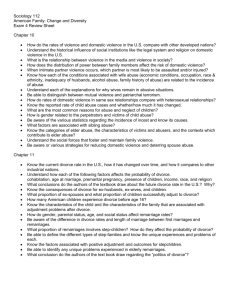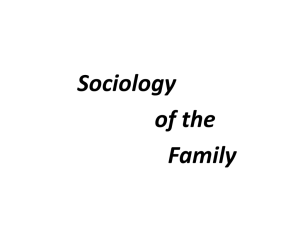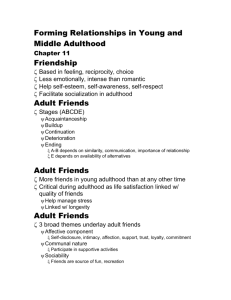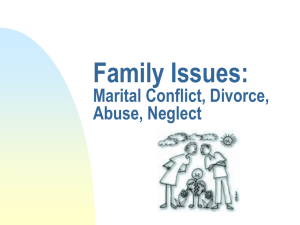Chapter 5: Family Problems
advertisement
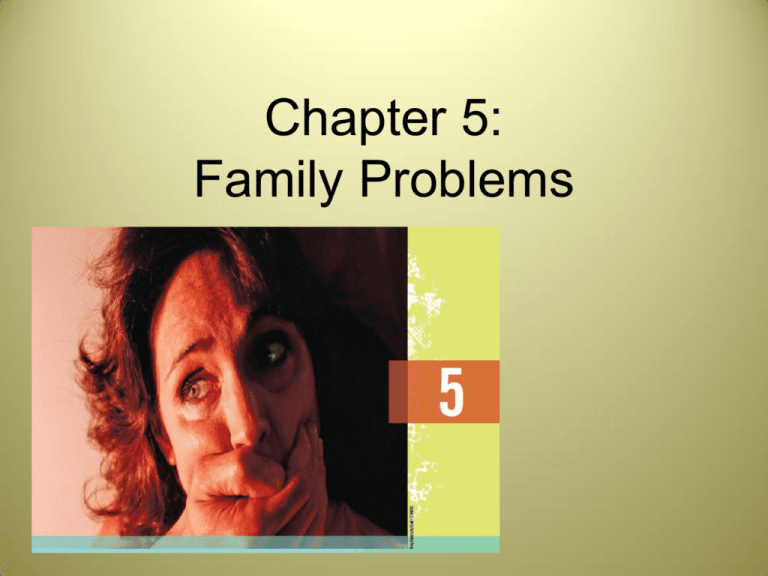
Chapter 5: Family Problems Chapter Outline • • • • The Global Context: Families of the World Changing Patterns in U.S. Families Sociological Theories of Family Problems Violence and Abuse in Intimate and Family Relationships • Problems Associated with Divorce • Understanding Family Problems The Global Context: Families of the World The Global Context: Families of the World • The U.S. Census Bureau defines family as a group of two or more people related by blood, marriage, or adoption. • Sociology offers a broader definition of family: A family is a kinship system of all relatives living together family, or recognized as a social unit, including adopted people. The Global Context: Families of the World Monogamy and Polygamy • In many countries, including the United States, the only legal form of marriage is monogamy— a marriage between two partners. • A common variation of monogamy is serial monogamy—a succession of marriages in which a person has more than one spouse over a lifetime but is legally married to only one person at a time. The Global Context: Families of the World Monogamy and Polygamy • Polygamy—a form of marriage in which one person may have two or more spouses— is practiced on all continents throughout the world. – The most common form of polygamy, known as polygyny, involves one husband having more than one wife. – A less common form of polygamy is polyandry—the concurrent marriage of one woman to two or more men. The Global Context: Families of the World Monogamy and Polygamy The Global Context: Families of the World Monogamy and Polygamy What Do You Think? The Global Context: Families of the World Division of Power in the Family • In many societies, male dominance in the larger society is reflected in the dominance of husbands over wives in the family. • In developed Western countries, although gender inequality persists, marriages tend to be more egalitarian, which means women and men view each other as equal partners who share decision making and assign family roles based on choice rather than on traditional beliefs about gender. The Global Context: Families of the World Social Norms Related to Child Bearing • In less developed societies, where social expectations for women to have children are strong, women on average have four to five children in their lifetime, and begin having them at an early age, with more than a third of women getting married by age 18. • Norms about childbirth out of wedlock also vary across the globe. – In the United States, 4 in 10 births in 2009 were to unmarried women. The Global Context: Families of the World Same-Sex Couples • Norms and policies concerning same-sex intimate relationships also vary around the world. In some countries, homosexuality is punishable by imprisonment or even death. • In a handful of countries, and in some U.S. states, samesex couples are granted legal rights to marry. – In the United States, support for gay marriage reached a milestone in 2011, when a poll of registered voters found that, for the first time, the majority (53%) support gay marriage. – And a 2011 Gallup poll found that the majority of U.S. adults (56%) view gay or lesbian relations as “morally acceptable.” The Global Context: Families of the World Same Sex Couples Same-Sex Couples in the Media: ABC’s Modern Family depicts a monogamous samesex couple who have adopted a child. Changing Patterns in U.S. Families • Some of the significant changes in U.S. families and households that have occurred over the past several decades include the following: – Increased singlehood and older age at first marriage. • Today, 13.8% of women and 20.4% of men ages 40 to 44 have never been married—the highest figures in this nation’s history. – Increased heterosexual and same-sex cohabitation. • The percentage of people who cohabited with their spouses before marriage more than doubled between 1980 and 2000, rising from 16% to 41%. Changing Patterns in U.S. Families What Do You Think? Changing Patterns in U.S. Families • Some states, cities, counties, and employers allow unmarried partners (same-sex and/or heterosexual partners) to apply for a domestic partnership designation, which grants them some legal entitlements, such as health insurance benefits and inheritance rights that have traditionally been reserved for married couples. Changing Patterns in U.S. Families Changing Patterns in U.S. Families • A new family form: Living apart together: – Some couples live apart in different cities or states because of their employment situation. Known as “commuter marriages,” these couples generally would prefer to live together, but their jobs require them to live apart. – Family scholars have identified this arrangement as an emerging family form known as living apart together (LAT) relationships. Changing Patterns in U.S. Families • Increased births to unmarried women: – The percentage of births to unmarried women rose to historic levels in 2009: 4 in 10 U.S. births in 2009 were to unmarried women. – The highest rates of non-marital births are among blacks, Native Americans/Alaskan natives, and Hispanics. Changing Patterns in U.S. Families Changing Patterns in U.S. Families • Increased divorce and blended families: – The refined divorce rate—the number of divorces per 1,000 married women— increased dramatically from 1960, to its peak around 1980, then decreased until 2005, before increasing again. – Between 40% and 50% of new U.S. marriages will end in divorce. – Most divorced individuals remarry and create blended families, traditionally referred to as stepfamilies. Changing Patterns in U.S. Families Changing Patterns in U.S. Families Changing Patterns in U.S. Families • Increased employment of mothers: – Employment of married women with children under age 18 rose from 24% in 1950, to 71% in 2010. – In the majority of married-couple families with children under 18, both parents are employed. Changing Patterns in U.S. Families: Public Attitudes toward Changes • A national survey found that U.S. adults are sharply divided in their judgments about the changes in U.S. families over the past several decades. • A Pew Research Center survey asked a national sample of 2,691 adults whether they considered the following seven trends to be good, bad, or of no consequence to society: 1. More unmarried couples raising children; 2. More gay and lesbian couples raising children; 3. More single women having children without a male partner to help raise them; 4. More people living together without getting married; 5. More mothers of young children working outside the home; 6. More people of different races marrying each other; 7. More women not ever having children Changing Patterns in U.S. Families: Public Attitudes toward Changes Changing Patterns in U.S. Families: Marital Decline? Or Marital Resiliency? • According to the marital decline perspective; 1. Personal happiness has become more important than marital commitment and family obligations 2. The decline in lifelong marriage and the increase in single-parent families have contributed to a variety of social problems, such as poverty, delinquency, substance abuse, violence, and the erosion of neighborhoods and communities. Changing Patterns in U.S. Families: Marital Decline? Or Marital Resiliency? • According to the marital resiliency perspective, “poverty, unemployment, poorly funded schools, discrimination, and the lack of basic services (such as health insurance and child care) represent more serious threats to the well-being of children and adults than does the decline in married two-parent families.” • According to this perspective, many marriages in the past were troubled, but because divorce was not socially acceptable, these problematic marriages remained intact. Sociological Theories of Family Problems: Structural-Functionalist Perspective • The structural-functionalist perspective views the family as a social institution that performs important functions for society, including producing and socializing new members, regulating sexual activity and procreation, and providing physical and emotional care for family members. • According to the structural-functionalist perspective, traditional gender roles contribute to family functioning: Women perform the “expressive” role of managing household tasks and providing emotional care and nurturing to family members, and men perform the “instrumental” role of earning income and making major family decisions. Sociological Theories of Family Problems: Conflict and Feminist Perspective • Conflict theory focuses on how capitalism, social class, and power influence marriages and families. • Feminist theory is concerned with how gender inequalities influence and are influenced by marriages and families. • Feminists are critical of the traditional male domination of families—a system known as patriarchy—that is reflected in the tradition of wives taking their husband’s last name and children taking their father’s name. • Patriarchy implies that wives and children are the property of husbands and fathers. Sociological Theories of Family Problems: Conflict and Feminist Perspective Sociological Theories of Family Problems: Conflict and Feminist Perspective Sociological Theories of Family Problems: Symbolic Interactionist Perspective • The symbolic interactionist perspective is concerned with how labels affect meaning and behavior. • Symbolic interactionists also point to the effects of interaction on one’s self-concept, especially the self-concept of children. • The symbolic interactionist perspective is useful in understanding the dynamics of domestic violence and abuse. Violence and Abuse in Intimate and Family Relationships • In U.S. society, people are more likely to be physically assaulted, abused and neglected, sexually assaulted and molested, or killed in their own homes rather than anywhere else, and by other family members rather than by anyone else. Violence and Abuse Intimate Partner Violence and Abuse • Intimate Partner Violence (IPV) Actual or threatened violent crimes committed against individuals by their current or former spouses, cohabiting partners, boyfriends, or girlfriends. • In the United States, women are more than four times more likely to be victims of IPV than are men. Violence and Abuse Intimate Partner Violence and Abuse • Johnson and Ferraro (2003) identified the following four patterns of partner violence: 1. 2. 3. 4. Common couple violence Intimate terrorism Violent resistance Mutual violent control Violence and Abuse Intimate Partner Violence and Abuse • Intimate partner abuse also takes the form of sexual aggression, which refers to sexual interaction that occurs against one’s will through use of physical force, threat of force, pressure, use of alcohol or drugs, or use of position of authority. • In 2010, 73% of female rape or sexual assault victims (12 and older) reported that the offender was an intimate partner, friend, or acquaintance. • A survey of college students found that, in the past 12 months, students were much more likely to have experienced an emotionally abusive relationship than a physically or sexually abusive relationship. Violence and Abuse Intimate Partner Violence and Abuse Violence and Abuse Intimate Partner Violence and Abuse Violence and Abuse Intimate Partner Violence and Abuse • Three Types of Male Perpetrators of Intimate Partner Violence: Researchers have identified three types of male abusers: 1. The psychopathic abuser 2. The hostile/controlling abuser 3. The borderline/dependent abuser Violence and Abuse Intimate Partner Violence and Abuse Violence and Abuse Intimate Partner Violence and Abuse • Why Do Some Adults Stay in Abusive Relationships? – Adult victims of abuse are commonly blamed for tolerating abusive relationships and for not leaving the relationship as soon as the abuse begins. – Multiple compelling reasons to stay: • including economic dependency • emotional attachment • commitment to the relationship • hope that things will get better • the view that violence is legitimate because they “deserve” it • guilt • fear Violence and Abuse Intimate Partner Violence and Abuse • Cycle of Abuse: A pattern of abuse in which a violent or abusive episode is followed by a makeup period when the abuser expresses sorrow and asks for forgiveness and “one more chance,” before another instance of abuse occurs. What Do You Think? Violence and Abuse Child Abuse • Child Abuse: The physical or mental injury, sexual abuse, negligent treatment, or maltreatment of a child younger than age 18 by a person who is responsible for the child’s welfare. • Neglect: A form of abuse involving the failure to provide adequate attention, supervision, nutrition, hygiene, health care, and a safe and clean living environment for a minor child or a dependent elderly individual. Violence and Abuse Child Abuse Violence and Abuse Child Abuse • Effects of Child Abuse: – Physical injuries sustained by child abuse cause pain, disfigurement, scarring, physical disability, and death. – In 2009, an estimated 1,770 U.S. children died of abuse or neglect. – Head injury is the leading cause of death in abused children. – Shaken baby syndrome, whereby a caregiver shakes a baby to the point of causing the child to experience brain or retinal hemorrhage, most often occurs in response to a baby, typically younger than 6 months, who will not stop crying. Violence and Abuse Child Abuse Violence and Abuse Child Abuse • Effects of Child Abuse: – Adults who were abused as children have an increased risk of a number of problems, including depression, smoking, alcohol and drug abuse, eating disorders, obesity, high-risk sexual behavior, and suicide. – Sexual abuse of young girls is associated with decreased self-esteem, increased levels of depression, running away from home, and alcohol and drug use. – Review of the research suggests that sexual abuse of boys produces many of the same reactions that sexually abused girls experience, including depression, sexual dysfunction, anger, self-blame, suicidal feelings, guilt, and flashbacks. Violence and Abuse Elder, Parent, Sibling, and Pet Abuse • Elder abuse includes physical abuse, sexual abuse, psychological abuse, financial abuse (such as improper use of the elder person’s financial resources), and neglect. • Two out of every three cases of elder abuse reported to state adult protective services involve women. • The most likely perpetrators are adult children. Violence and Abuse Elder, Parent, Sibling, and Pet Abuse Violence and Abuse Elder, Parent, Sibling, and Pet Abuse • Parent Abuse: Some parents are victimized by their children’s violence. – More violence is directed against mothers than against fathers – Sons tend to be more violent toward parents than are daughters Violence and Abuse Elder, Parent, Sibling, and Pet Abuse • Sibling Abuse: The most prevalent form of abuse in families is sibling abuse. – 98% of the females and 89% of the males in one study reported having been emotionally abused by a sibling. – 88% of the females and 71% of the males reported having been physically abused by a sibling. Violence and Abuse Elder, Parent, Sibling, and Pet Abuse • Pet Abuse: – As pets are often viewed as “members of the family,” abused pets (or companion animals) can be considered victims of family violence. Violence and Abuse Contributing Factors • Individual and Family Factors: – Several factors are associated with a higher risk that a person will become abusive. – Risk factors include: having witnessed or been a victim of abuse as a child, past violent or aggressive behavior, lack of employment and other stressful life events or circumstances, and drug and alcohol use. – Alcohol use is involved in 50% to 75% of incidents of physical and sexual aggression in intimate relationships. Violence and Abuse Contributing Factors • Gender Inequality and Gender Socialization: – This traditional view of women as property may contribute to men’s doing with their “property” as they wish. – In a study of men in battering intervention programs, about half of the men viewed battering as acceptable in certain situations – The view of women and children as property also explains marital rape and father-daughter incest. – Traditional male gender roles have taught men to be aggressive and to be dominant in male–female relationships. Violence and Abuse Contributing Factors • Acceptance of Corporal Punishment: – Corporal punishment: the intentional infliction of pain intended to change or control behavior—is widely accepted as a parenting practice. – In a review of research on corporal punishment, Straus (2010) concluded that, in the United States, corporal punishment is • (1) almost universal—94% of toddlers are spanked; • (2) chronic—toddlers are often spanked three or more times a week; • (3) often severe, with more than one in four parents using an object such as a paddle or belt to punish their children; and • (4) of long duration—13 years for a third of U.S. children, 17 years for 14 percent of U.S. children. Strategies for Action Prevention Strategies • Abuse-prevention strategies include public education and media campaigns, which may help to reduce domestic violence. • Other abuse-prevention efforts focus on parent education to teach parents realistic expectations about child behavior and methods of child discipline that do not involve corporal punishment. • Another abuse-prevention strategy involves reducing violence-provoking stress. What Do You Think? Strategies for Action Responding to Domestic Violence and Abuse • Shelters and Safe Houses: Between 1993 and 2004, about 21% of female victims and 10% of male victims of nonfatal IPV contacted a private or government agency for assistance. • Shelters provide abused women and their children with housing, food, and counseling services. • Safe houses are private homes of individuals who volunteer to provide temporary housing to abused people who decide to leave their violent homes. Strategies for Action Responding to Domestic Violence and Abuse • Foster Care Placement: Children who are abused in the family may be removed from their homes and placed in government-supervised foster care. • Due to the economic recession, more prospective adoptive parents are considering adopting foster children because they cannot afford private adoptions. • Another problem that plagues the foster care system is that, although it is intended to protect children from abuse, foster parents or caregivers sometimes abuse the children. Problems Associated with Divorce • The United States has the highest divorce rate among Western nations. • The lifetime probability of divorce among couples getting married today is between 40% and 50%. • Divorce is considered problematic because of the negative effects it has on children as well as the difficulties it causes for adults. Problems Associated with Divorce Problems Associated with Divorce Social Causes of Divorce • Understanding the high rate of divorce in U.S. society requires awareness of how the following social and cultural factors contribute to marital breakup: 1. Changing function of marriage. 2. Increased economic autonomy of women. 3. Increased work demands and economic stress. 4. Inequality in marital division of labor. 5. Liberalized divorce laws. 6. Increased Individualism 7. Weak social ties. 8. Increased life expectancy. Problems Associated with Divorce Social Causes of Divorce 1. Changing Function of Marriage 2. Increased Economic Autonomy of Women 3. Increased work demands and economic stress 4. Inequality in Marital Division of Labor 5. Liberalized Divorce Laws 6. Increased Individualism 7. Weak Social Ties 8. Increased Life Expectancy Problems Associated with Divorce Social Causes of Divorce • Second Shift: The household work and child care that employed parents (usually women) do when they return home from their jobs. • No-fault Divorce: A divorce that is granted based on the claim that there are irreconcilable differences within a marriage (as opposed to one spouse being legally at fault for the marital breakup). • Individualism: The tendency to focus on one’s individual self-interests and personal happiness rather than on the interests of one’s family and community. Problems Associated with Divorce Social Causes of Divorce Problems Associated with Divorce Social Causes of Divorce Problems Associated with Divorce Consequences of Divorce • Physical and Mental Health Consequences – Numerous studies show that divorced individuals have more health problems and a higher risk of mortality than married individuals; – Divorced individuals also experience lower levels of psychological well-being, including more unhappiness, depression, anxiety, and poorer self-concepts. Problems Associated with Divorce Consequences of Divorce • Economic Consequences: – Following divorce, there tends to be a dramatic drop in women’s income and a slight drop in men’s income. – Compared with married individuals, divorced individuals have a lower standard of living, have less wealth, and experience greater economic hardship, although this difference is considerably greater for women than for men. Problems Associated with Divorce Consequences of Divorce • Effects on Children and Young Adults – Parental divorce is a stressful event for children and is often accompanied by a variety of stressors, such a • continuing conflict between parents, • a decline in the standard of living, • moving and perhaps changing schools, • separation from the noncustodial parent (usually the father), • parental remarriage. – These stressors place children of divorce at higher risk for a variety of emotional and behavioral problems. Problems Associated with Divorce Consequences of Divorce • Effects on Father-Child Relationships – Some research has found that young adults whose parents divorced are less likely to report having a close relationship with their father compared with children whose parents are together – Children may benefit from having more quality time with their fathers after parental divorce. – Some fathers report that they became more active in the role of father after divorce. Problems Associated with Divorce Consequences of Divorce • Parental Alienation – Parental alienation refers to the intentional efforts of one parent to turn a child against the other parent and essentially destroy any positive relationship a child has with the other parent. – Long-term effects of parental alienation on children can include low self-esteem, depression, drug and alcohol problems, mistrust, and divorce (Baker 2007). – The effects on the rejected parent are equally devastating. Problems Associated with Divorce Consequences of Divorce Problems Associated with Divorce Consequences of Divorce Strengthening Marriage & Alleviating Problems of Divorce Strategies to Strengthen Marriage and Prevent Divorce • Marriage Education – Marriage education, also known as family life education, includes various types of workshops and classes that: • (1) teach relationship skills, communication, and problem solving; • (2) convey the idea that sustaining healthy marriages requires effort; • (3) convey the importance of having realistic expectations of marriage, commitment, and a willingness to make personal sacrifices Strengthening Marriage & Alleviating Problems of Divorce Strategies to Strengthen Marriage and Prevent Divorce • Covenant Marriage and Divorce Law Reform – With the passing of the 1996 Covenant Marriage Act, Louisiana became the first state to offer two types of marriage contracts: • (1) the standard marriage contract that allows a no-fault divorce (after a sixmonth separation), or • (2) a covenant marriage, which permits divorce only under condition of fault (e.g., abuse, adultery, or felony conviction) or after a two-year separation. What Do You Think? Strengthening Marriage & Alleviating Problems of Divorce Strategies to Strengthen Marriage and Prevent Divorce • Workplace and Economic Supports – The most important pro-marriage and divorceprevention measures may be those that maximize employment and earnings. – Given that research finds a link between financial hardship and marital quality, policies to strengthen marriage should include a focus on the economic well-being of poor and nearpoor couples and families. Strengthening Marriage & Alleviating Problems of Divorce Strategies to Strengthen Families During and After Divorce • The post-divorce conflict between parents and not the divorce itself is most traumatic for children. • Forgiveness: Research suggests that divorced parents who forgive each other are more likely to have positive and cooperative co-parenting after divorce. Strengthening Marriage & Alleviating Problems of Divorce Strategies to Strengthen Families During and After Divorce • Divorce Mediation: In divorce mediation, divorcing couples meet with a neutral third party, a mediator, who helps them resolve issues of property division, child support, child custody, and spousal support (i.e., alimony) in a way that minimizes conflict and encourages cooperation. • Divorce Education Programs: Divorce education programs are designed to help parents who are divorced or planning to divorce reduce parental conflict and educate them about the factors that affect their children’s adjustment. What Do You Think? Understanding Family Problems • Although domestic violence and divorce may appear to result from individual decisions, myriad social and cultural forces influence these decisions. • The impact of family problems, including divorce and abuse, is felt not only by family members but also by society at large. • For some, the solution to family problems implies encouraging marriage and discouraging other family forms, such as single parenting, cohabitation, and same-sex unions. • However, many family scholars argue that the fundamental issue is making sure that children are well cared for, regardless of their parents’ marital status or sexual orientation. Quick Quiz 1. Personal happiness becoming more important than marital commitment and family obligations, is known as the: A. B. C. D. covenant marriage. plural marriage. marital decline perspective. marital resiliency perspective. Answer: C • Personal happiness becoming more important than marital commitment and family obligations, is known as the marital decline perspective. Quick Quiz 2. According to the structural-functionalist perspective, what is the cause of the high rate of divorce? A. B. C. D. increased marital infidelity rapid social change government policies increased expectations Answer: B • According to the structural-functionalist perspective, rapid social change is the cause of the high rate of divorce. Quick Quiz 3. Which sociological perspective points to the change in societal definitions of divorce, as a reason for the increase in divorce? A. B. C. D. symbolic interactionism structural functionalism conflict theory exchange theory Answer: A • Symbolic interactionism points to the change in societal definitions of divorce, as a reason for the increase in divorce. Quick Quiz 4. According to conflict theorists, what contributes to domestic violence? A. B. C. D. increased emotional expectations the second shift the system of patriarchy rapid social change Answer: C • According to conflict theorists, the system of patriarchy contributes to domestic violence. Quick Quiz 5. The adoption of no-fault divorce laws, falling wages, and other changes in social institutions contribute to family problems according to: A. B. C. D. structural-functionalists. exchange theorists. conflict theorists. symbolic interactionists. Answer: A • The adoption of no-fault divorce laws, falling wages, and other changes in social institutions contribute to family problems according to structural-functionalists.

